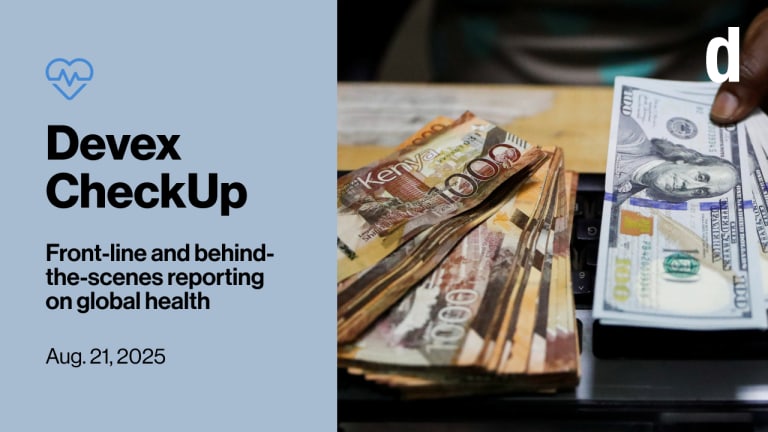Inequality is fueling drug resistance across the African continent
Africa is witnessing a “documented crisis” of drug resistance in diseases. This is broadly due to improper antibiotic use in the health and agriculture sectors, as well as substandard or fake antibiotics.
The bacteria that causes cholera is evolving to become more resistant to drugs that treat the illness. In Kenya, for example, strains with extended-spectrum beta-lactamase resistance — which are extremely drug resistant — made their first presence in the East African country just over a decade ago, Samuel Kariuki, eastern Africa director for the Drugs for Neglected Diseases initiative, or DNDi, told an audience at a recent public health conference in Zambia. These strains are more persistent in the environment than their predecessors and outbreaks hit when least expected, including during the dry season — which can come as a shock for a water-borne illness. His teams have studied drug resistance of this bacteria, and others, in informal settlements in Nairobi — where overcrowding along with poor water and sanitation infrastructure become “a recipe for accelerated transmission.” They found infections were largely driven by bacterial persistence in open drains and contamination of containers used to fetch water from taps. “We're facing unprecedented times, when some of these strains are drug-resistant and we can no longer rely on common treatments,” said Kariuki. “It’s one of the most important pandemics that we're facing in Africa.” It’s also a top threat globally that’s putting the efficacy of current drug regimes under fire — pathogens become so skilled at surviving a drug that people die from treatable illnesses. This problem manifests itself differently across regions — Africa, where poverty is part of the equation, has the world’s highest mortality rate from antimicrobial-resistant, or AMR, infections. “Poverty and inequality are fertile ground for the emergence of antimicrobial resistance in many African countries,” said Michelle Nderu, project officer at the European and Developing Countries Clinical Trials Partnership. The continent is witnessing a “documented crisis” of drug resistance in diseases such as HIV, malaria, tuberculosis, typhoid, cholera and dysentery, she said. The causes broadly include improper antibiotic use in the health and agriculture sectors, as well as substandard or fake antibiotics. And while any use of antimicrobials can ultimately lead to resistance, there are ways to delay it, Kariuki said. This includes the continent embracing a “One Health” approach, which aims to strengthen collaborations between the human, animal and environmental health sectors. And within that, ensuring antibiotics are used properly and infections avoided in the first place. It also includes strengthening regulatory systems, and post-market surveillance for substandard and counterfeit medicines. Overuse and underuse Health professionals need access to quality medicines, treatment guidelines, diagnostics and surveillance data in order to make informed decisions, said Yewande Alimi, AMR and One Health unit lead at the Africa Centres for Disease Control and Prevention. Health professionals should provide prescriptions for antibiotics — a set number of quality pills for a set number of days. When that doesn’t happen, pathogens genetically adapt to develop resistance to the drugs. But in settings where people have limited access to health care, people may not know this and may stray from guidelines. Poverty can lead to the sharing of medicines, said Evelyn Gitau, director of research capacity strengthening at the African Population and Health Research Center. People may take pills until they feel better, and then share the rest with an ailing family member. Or they may stash away the final set of pills from their prescribed regimen for the next time they’re sick. "There's an issue of overuse and underuse because of access to health care and affordability of medications,” Gitau said. She added that cheaper antibiotics are often more resistant, whereas more effective ones are often more expensive and less accessible. It’s also a matter of training pharmacists. Pharmacies dispense antibiotics without prescriptions in many places. One study in Moshi municipality, in Kilimanjaro, Tanzania, found 92% of pharmacies dispensed antibiotics without a prescription. And there’s a need to better communicate the problem with accessible terminology, translated into multiple languages, said Marc Mendelson, head of the infectious diseases division at the University of Cape Town. “Nobody understands antimicrobial resistance,” he said. Better diagnoses also play a role. A proper diagnosis can be followed by a treatment plan. Without a correct diagnosis, someone might self-prescribe with antibiotics of their choosing — or receive the wrong medications from a health professional. And that’s why it's crucial health workers get access to innovations, Nderu said, such as the GeneXpert test, which can give a quick tuberculosis diagnosis. Neglected tropical diseases are also a subset of diseases that routinely go undiagnosed, said Yenew Kebede Tebeje, acting head of the surveillance and disease intelligence division at Africa CDC. Instead, they are often treated with mass drug administration — where whole communities are targeted with a drug to eliminate the disease. This overuse can fuel AMR. “We are really emphasizing the need to individualize treatment programs,” Tebeje said. When antibiotics become less effective, there’s also not a healthy pipeline of new ones to replace them, said Carol Ruffell, head of the southern Africa joint office for DNDi and Global Antibiotic Research and Development Partnership, or GARDP. The last new class of antibiotics to hit the market was discovered in 1987, she said. It’s critical that new antibiotics are brought to market and that there’s equitable access to them, she said. One study found only 12 of the 25 new antibiotics that entered the market between 1999 and 2014 had registered sales in more than 10 countries. Blanket use in livestock rearing The crisis goes beyond human health. There’s a lot of misuse and overuse of antibiotics in livestock farming, especially in intensive agriculture systems where farmers want shortcuts, DNDi’s Kariuki said. A large portion of antimicrobials are used as a prophylaxis, particularly in chicken farming — used to prevent disease rather than treat it — with this overuse driving AMR, he said. And the molecules used in human medicine are the same class of antimicrobials used in animal health, he added. "Any use in one sector will definitely lead to resistance across all the sectors,” Kariuki said. “These bugs don't know boundaries.” And antibiotics used in the livestock sector are less regulated than human medicines, he said, adding that sometimes local producers sell mislabeled products to farmers laced with antibiotics. Teaching farmers hygienic conditions for animal rearing that prevent infections is critical. This includes ensuring adequate aeration in chicken sheds, employing feeding practices with clean water, and having measures in place to ensure people coming in and out of a farm aren’t spreading pathogens, Kariuki said. Limiting infections While AMR is a global problem — priorities differ by region, DNDi-GARDP’s Ruffell said. In high-resource settings, infectious disease burdens are reasonably low, and access to health care is more prevalent. In these circumstances, good stewardship of antibiotics is a top priority, she said. In low-resource settings with high burdens of infectious diseases and limited access to health care, antibiotic stewardship is still important, but efforts to reduce infectious disease burdens are even more important, Ruffell said. This is coupled with the need to improve access to essential antibiotics because of frequent stockouts. “Limited transmission is simply the most cost-effective way for us as a continent to address microbial resistance,” Africa CDC’s Alimi said. And that includes widespread use of vaccines. “Vaccines have proven to be very cost-effective in reducing the need to consume antibiotics — be it in the human health sector or the animal health sector,” Alimi said. And infection prevention and control measures in health facilities. “A severe shortage of health care workers, overcrowded wards and insufficient resources create a breeding ground for infections, some of which are antibiotic-resistant,” the European and Developing Countries Clinical Trials Partnership’s Nderu said. High levels of drug-resistant bacteria are often found in health center wastewater — so surveillance of this wastewater can provide a warning sign that resistance is growing. And waste in general, from the pharmaceutical, agriculture and health care sectors, must be handled properly so it doesn’t pollute the surrounding environment with resistant bugs, Ruffell said. Continental approach There’s still a lot of unknowns around antimicrobial resistance across Africa and the rate at which it’s spreading is complex to measure, Africa CDC’s Alimi said. A report on data from 14 African countries — which Alimi said is the largest granular data on this issue coming from the continent — found most laboratories across Africa aren’t ready for AMR testing and only 1.3% of the 50,000 medical laboratories surveyed conduct bacteriology testing. Enhancing lab capacity for surveillance is crucial, she said — and then sharing that data. “It's quite important for that multisectorial cross-border collaboration between Africa as well as the rest of the world,” Alimi said. The African Union has a framework for AMR control and it’s currently setting up the African Medicines Agency, which will work to harmonize regulatory systems across the continent and combat substandard and falsified medical products circulating in the market. But it's still early days in efforts to create a united front against AMR across Africa. “The challenges remain enormous and there's still much work that needs to be done,” Nderu said.
The bacteria that causes cholera is evolving to become more resistant to drugs that treat the illness.
In Kenya, for example, strains with extended-spectrum beta-lactamase resistance — which are extremely drug resistant — made their first presence in the East African country just over a decade ago, Samuel Kariuki, eastern Africa director for the Drugs for Neglected Diseases initiative, or DNDi, told an audience at a recent public health conference in Zambia.
These strains are more persistent in the environment than their predecessors and outbreaks hit when least expected, including during the dry season — which can come as a shock for a water-borne illness.
This article is free to read - just register or sign in
Access news, newsletters, events and more.
Join usSign inPrinting articles to share with others is a breach of our terms and conditions and copyright policy. Please use the sharing options on the left side of the article. Devex Pro members may share up to 10 articles per month using the Pro share tool ( ).
Sara Jerving is a Senior Reporter at Devex, where she covers global health. Her work has appeared in The New York Times, the Los Angeles Times, The Wall Street Journal, VICE News, and Bloomberg News among others. Sara holds a master's degree from Columbia University Graduate School of Journalism where she was a Lorana Sullivan fellow. She was a finalist for One World Media's Digital Media Award in 2021; a finalist for the Livingston Award for Young Journalists in 2018; and she was part of a VICE News Tonight on HBO team that received an Emmy nomination in 2018. She received the Philip Greer Memorial Award from Columbia University Graduate School of Journalism in 2014.








